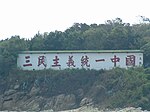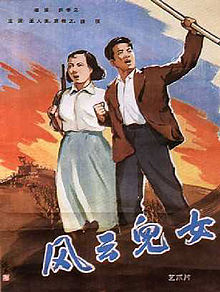Propaganda in the Republic of China
This article may be expanded with text translated from the corresponding article in Chinese. (November 2020) Click [show] for important translation instructions.
|

Propaganda in the Republic of China refers to propaganda used by the Republic of China government and has been an important tool since its inception in 1912. The term xuanchuan (Chinese: 宣傳 "propaganda; publicity") can have either a neutral connotation in official government contexts or a pejorative connotation in informal contexts.[1] Some xuanchuan collocations usually refer to "propaganda" (e.g., xuānchuánzhàn 宣傳戰 "propaganda war"), others to "publicity" (xuānchuán méijiè 宣傳媒介 "mass media; means of publicity"), and still others are ambiguous (xuānchuányuán 宣傳員 "propagandist; publicist").[2] It also was an important tool in legitimizing the Kuomintang controlled Republic of China government that retreated from Mainland China to Taiwan in 1949.
Themes[]
Patriotism[]


Because the national government of this time was weak, it was difficult for any censorship or propagandistic measures to be carried out effectively. However, a bureau was set up to control the production and release of film in China. Also, newspapers unfavourable to the central government could be harassed at will. Following the Northern Expedition, the power of the central government increased significantly and propaganda campaigns became more effective. Propaganda was produced with different patriotic themes, such as nationalism.[citation needed]
Second Sino-Japanese War[]

The Republic of China produced propaganda against Japan during the Second Sino-Japanese War, to booster morale and bolden resistance to the invasion.[3][page needed], during the Chinese Civil War and Second Sino-Japanese War respectively.

Kwang-jeou Hu-man courageous battle poster.

Anti-Japanese propaganda poster published after revenge by Koreans in the Wanpaoshan Incident
Anti-communism[]
In Mainland China[]

During the Chinese Civil War, usage of propaganda against the Communist Party of China was extensively used.[citation needed]
Chiang Kai-shek attacked the CPC in 1943 with the propaganda piece China's Destiny, which questioned the CPC's power after the war, while the CPC strongly opposed Chiang's leadership and referred to his regime as fascist in an attempt to generate a negative public image.[4]
In Taiwan[]

One of the main tools for disseminating propaganda in Taiwan has been the Government Information Office and the various media properties controlled by the Kuomintang and the government. Besides controlling commercial TV and radio stations, there also exists a police radio station that often broadcast "educational" plays with propagandistic value and a film bureau. After the Kuomintang fled to Taiwan, propaganda through public education in Taiwan was an important tool in creating a Chinese national identity among Taiwanese, and preparing the people for "a counter-offensive" against the PRC. Although the government is now democratic, the legacy of authoritarian rule has created a confusion of identity in Taiwan, with many adults having grown up thinking that the ROC was going to launch a "counter-offensive" against the PRC and with Mandarin becoming the most common language. Previously, the people were educated in the evils of the Communists, and the good of the Nationalists, with many Taiwanese remembering lore taught in elementary school on the wisdom of Chiang Kai-shek.
The Kuomintang also published numerous publications following their retreat to Taiwan, including the Free China Journal. Its popularity soared as the editors and writers analyzed political situations at the time, sometimes even advising or criticizing the government in earnest.
Occasionally, the ROC has attempted to spread propaganda in PRC-controlled areas, usually in the form of leaflet drops over coastal provinces, calling for the locals to rebel against CPC rule, accompanied by promise that the ROC will one day liberate the mainland. This proved to be ineffective and after several years was largely discontinued.
Today, Taiwan after democratization has passed a law to abolish the Government Information Office and replace it with a National Communications Commission, styled after the FCC in the United States. The Kuomintang still controls many media properties, though its influence is much less than before. The GIO today still provides some subsidies for films, but for cultural rather than political reasons. Most films in Taiwan today are Hollywood movies and theaters are all commercially run for-profit enterprises.
Some activities of the Taiwanese government have been described as propaganda.[5][6] Much of it has been directed against the mainland People's Republic of China and its propaganda.[7]
Media[]
Films[]

In the Republic of China, movies were created even during wartime, such as Mulan Joins the Army (1939)[8] with its story of a young Chinese peasant fighting against a foreign invasion, and Children of Troubled Times (1935), a patriotic Chinese film about the Japanese invasion of China[citation needed], and known for being the origin of the "March of the Volunteers", now the national anthem of the People's Republic of China.
Patriotic songs[]
There were several songs written in the Republic of China with patriotic messages. Some, such as 800 Heroes Song, Guerrillas' Song, and The Sword March were written in the Second Sino-Japanese War, while others such as Go and Reclaim the Mainland and The Anti-Communist and Anti-Russian Aggression Song were written with anti-communist messages.
See also[]
- Cross-Strait war of propaganda
- Cinema of China
- Propaganda in the People's Republic of China
- Voice of Free China
- Radio Taiwan International
References[]
- ^ Kingsley Edney (2014), The Globalization of Chinese Propaganda: International Power and Domestic Political Cohesion, Palgrave Macmillan, pp. 22, 195.
- ^ Translations from John DeFrancis, ed. (2003), ABC Chinese-English Comprehensive Dictionary, University of Hawaii Press, p. 1087.
- ^ Shuge Wei. News under fire : China's propaganda against Japan in the English-Language Press, 1928-1941. ISBN 9789888390618. OCLC 1039082220.
- ^ Chen, Jian. [2001] (2001). Mao's China and the Cold War. The University of North Carolina Press. ISBN 0-807-84932-4.
- ^ Rawnsley, Gary (2000-05-01). "Selling Taiwan: Diplomacy and propaganda". Issues and Studies. 36 (3): 1–25.
- ^ Rawnsley, Gary D. (1999-12-01). "Taiwan's propaganda cold war: The offshore islands crises of 1954 and 1958". Intelligence and National Security. 14 (4): 82–101. doi:10.1080/02684529908432572. ISSN 0268-4527.
- ^ Rawnsley, Gary D. (2005-10-01). "Old wine in new bottles: China—Taiwan computer-based 'information warfare' and propaganda". International Affairs. 81 (5): 1061–1078. doi:10.1111/j.1468-2346.2005.00502.x. ISSN 0020-5850.
- ^ Ministry of Culture Staff (2003). "Sole Island Movies". ChinaCulture.org. Archived from the original on 2006-08-26. Retrieved 2006-08-18.
- Propaganda in China
- Propaganda in Taiwan
- Mass media in Taiwan
- Kuomintang




